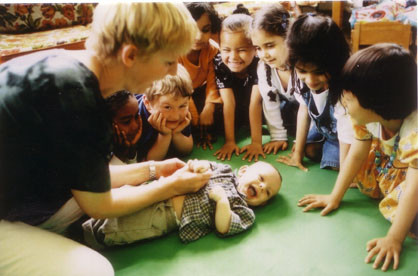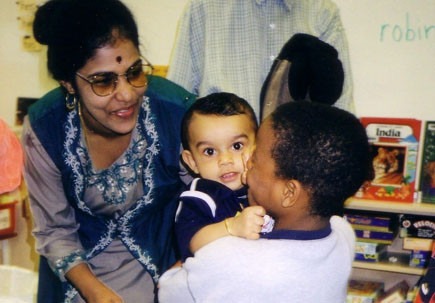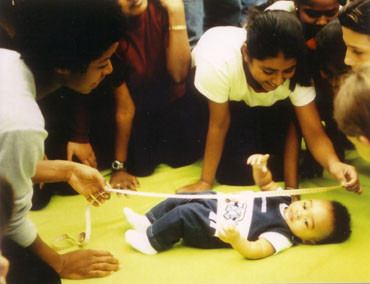Samantha Ponic stood before 26 seven- and eight-year-olds in a Toronto public school classroom, ready to help with that day’s lesson. She had slipped out of her pink and white bunny ears hat, revealing a new clump of silky brown hair to the class. This was her third visit in three months, and she commanded the attention of every student in the room—even though she was only six months old.
“Do you notice any changes in Samantha since her last visit? asked Linda Armstrong, who was holding Samantha’s arms so the infant could stand upright. The children waved their hands in the air, anxious to offer their observations.
 © Roots of Empathy
© Roots of Empathy
“She has more hair.”
“She’s grown taller.”
“She looks happy.”
Armstrong affirmed each child’s statement and then tossed out another question: “How do you know she’s happy?”
“Because she’s smiling,” several of the children answered instantly, in unison.
Armstrong wasn’t just testing the children’s observational skills. Together with Samantha, she was helping lay the foundation for a more caring and compassionate community in this second- and third-grade classroom.
Armstrong is an instructor with Roots of Empathy, a Canadian program that aims to reduce aggression and build empathy among school children ages 3 to 14. At the heart of the program are infants like Samantha Ponic, who, along with one or both parents, visit the same classroom in their local neighborhoods once a month for an entire school year. A certified Roots of Empathy instructor works with the children in the class before, during, and after each family visit—27 classes in all—and coaches them to observe the baby’s development, respond to her needs, and celebrate milestones in her life.
The program rests on the premise that by forming a collective attachment to “their” baby, children in each classroom will strengthen their relationships with one another and learn “emotional literacy”—the ability to identify emotions, explain why people feel these emotions, and develop ways for handling their own emotions. It draws upon years of research suggesting that when children can understand how others feel, they are less likely to hurt them by bullying, exclusion, and aggression, and are more likely to be kind and altruistic. At the same time, Roots of Empathy helps the next generation of parents appreciate the emotional and practical demands of raising children.
“The core of our humanity is the ability to feel what the other person feels, not just for them—to be able to take the other’s perspective,” said Roots of Empathy creator Mary Gordon. “We think we’re islands of emotional pain unless we hear others discuss their feelings.”
Gordon, a former kindergarten teacher, started Roots of Empathy in 1996 as a pilot program in two Toronto classrooms. By the 2004-05 school year, four years after Roots of Empathy became a non-profit organization, the program is thriving in 1,141 classrooms with 28,535 students in eight of Canada’s 10 provinces. A successful pilot of the program ran in Japan, though it must secure more funding and be further researched before it can move forward there. Thirty-two classrooms in Australia are currently running their own pilot, and interest has been shown in New Zealand and the United States in expanding the program to those countries.
 © Roots of Empathy
© Roots of Empathy
Though the program isn’t quite 10 years old, its origins go back to the late 1960s and early 1970s, when Gordon taught junior kindergarten—the equivalent of pre-school in the United States—in inner-city schools. She could see that the parents of her students adored their children and wanted the best for them, but they often lacked proper parenting skills, did not know much about child development, and had limited expectations for their children. What’s more, Gordon believed that poor parenting led to intergenerational cycles of despair, abuse, and low literacy, which also contributed to increasing rates of aggression and violence. She thought the best way to tackle this problem was through public education. Drawing on her own experiences as a mother and teacher, she started several in-school groups for young mothers and their children. Through play and positive reinforcement, the mothers learned to understand and enjoy their babies’ development.
After Gordon stopped teaching, she worked with the Toronto District School Board in expanding this model to other schools. She eventually helped set up 50 school-based Parenting and Family Literacy Centers in Toronto. When she did outreach for these parenting centers, she brought a friend’s baby along and observed how people would approach her without fear. This made her even more aware of the mother-child bond and the positive feelings babies inspire in almost everyone. Through these experiences, and relying on her own intuition, she thought that by bringing an infant into public school classrooms and by teaching parenting skills to children, children could learn to be more empathetic, compassionate, and caring.
“A baby brings out our most generous, inclusive, kindest instincts,” said Gordon. “Its body is a theatre of emotions. It communicates in the most pure, instinctive way.”
In launching Roots of Empathy, Gordon created a program that was based upon prior scientific research, and her ideas have earned the respect and support of the scientific community.
“Roots of Empathy is well-grounded in prior intervention studies that show we can foster empathic tendencies in people,” said Gustavo Carlo, an associate professor of developmental psychology at the University of Nebraska-Lincoln. And when empathy is fostered in young children, added Carlo, research suggests that these children tend to be more empathetic over the rest of their lives.
The Roots of Empathy curriculum includes more than 600 pages of detailed lesson plans for helping children understand babies’ needs, including how to interpret their emotions, how they communicate, and how to care for their safety. Roots of Empathy not only teaches students the emotional, economic, and social responsibilities of parenting, but also implicitly dissuades them from becoming parents before they are ready.
At the youngest ages, students in Roots of Empathy sing songs and recite rhymes as a way of bringing the children together, setting the tone for the class, getting the baby’s attention, and exploring the baby’s personality, as they see which rhymes they respond to the most. Every Roots of Empathy class has a baby doll in it, and the children practice holding it with their hands, supporting its head, and soothing it by rocking it or putting its head on their shoulder.
In the intermediate classes, students observe the baby’s facial expressions and body language as a way of learning how to read emotions in other people. Using line drawings of facial expressions, the Roots of Empathy instructor will show them how the eyes, nose, and mouth may look when the baby is happy, shy, sleepy, or upset, and the children have to guess which emotion is being portrayed.
 © Roots of Empathy
© Roots of Empathy
“There’s always interesting discussion because these drawings can be interpreted in different ways, and the children learn it’s difficult to understand what someone is feeling unless you ask questions and look deeper,” said instructor Linda Armstrong. “They discover that there’s a lot of conflict based on misinterpretation.”
This exercise leads into the subject of bullying, which, Armstrong has observed, can often happen because children fail to read the emotional cues expressed by their peers. One Roots of Empathy exercise divides the class into groups of bullies and the bullied, so they can appreciate how it feels to be the victim of bullying. They’re encouraged to think of non-violent ways of defending someone who’s been bullied, stand up for themselves and their friends, or find an authority figure to help them. Ultimately, they learn that everyone has the right to feel safe and secure.
In a senior Roots of Empathy class, one exercise links milestones in their baby’s life with potential hazards. If the baby can grip things, she can put them in her mouth; when she can stand up, she can take things off tables; when she’s mobile, she can fall down. Children discuss ways to protect the baby and question her mother about her feelings and concerns as her baby becomes more vulnerable to danger and needs to be watched with more vigilance. They learn about Sudden Infant Death Syndrome, the effects of second-hand smoke, Fetal Alcohol Spectrum Disorder, Shaken Baby Syndrome, and why it’s important not to drink when pregnant.
They’ll also brainstorm about milestones in their own lives and how to be responsible for their own safety. They begin to look at themselves as global citizens through an exercise called “the rings of caring,” where they discuss ways of caring for themselves, their families, and their friends. Then they broaden their circle to include their neighborhoods, their city, their country, and the world. They may start by considering how to care for themselves as they mature, but the goal is to connect a sense of personal responsibility with a sense of responsibility for global issues like pollution, famine, and AIDS.
A former schoolteacher, Armstrong has found that students are kinder to each other in Roots of Empathy classes. “There’s a change in their interpersonal skills,” she said. “They listen more to each other and come to each other’s rescue. They think of ways to make other people happier.”
Liz Papanthanasakis has observed the effects of the program as both a parent and a teacher. Papanthanasakis has taught for more than 18 years, six of them at Winchester Public School, the same ethnically diverse school where Samantha Ponic has been making her monthly classroom visits. She also attended Winchester as a student, and her two sons, ages seven and 12, go there now. Both are currently taking Roots of Empathy, her eldest for the second consecutive year.
“The difference it’s making with my boys is in their reactions to younger children: they’re so nurturing,” she said. “Both boys come home and share their experiences with ‘their’ baby, and they’re so well-mannered with the babies in our family. The toddlers love being around them. Last June, Peter, my eldest, brought home a picture of his baby. He wasn’t even in it, but he was so excited about showing her to me.”
As a veteran of five Roots of Empathy classes, Papanthanasakis has found simple ways to integrate the program’s curriculum into the academic agenda. For example, in math, her students calculate the cost effectiveness of cloth diapers versus disposables and discuss the environmental effects of choosing one over the other. In science, they may discuss why a baby must ease from baby food to solids. “You can extend Roots of Empathy into your own programs, and the children get a lot out of it,” she said.
She remembered a nine-year-old boy in her fourth grade class a few years back who was extremely verbally aggressive. A name-caller with an excellent vocabulary, he was generally rude and badly socialized, she said.
“But when the baby arrived, he softened his words and his demeanor,” she said. “It was so amazing to watch. The baby really touched him. Halfway through the year, his mother had a baby girl and he was able to relive what he was learning in the Roots of Empathy class and extend that gentleness and softness toward his baby sister. That was two years ago, and though he can still be aggressive, now he’s more aware. He’s learning to be more mannerly, and that came with the empathy he learned in this program.”
In 2000, the same year that Roots of Empathy first extended beyond the Canadian province of Ontario, Kimberley Schonert-Reichl began to evaluate the program’s impact. An associate professor of psychology at the University of British Columbia, Schonert-Reichl has co-authored 14 different Roots of Empathy studies and is currently involved in additional research on the program, though she is not officially affiliated with it and receives no funding from it.
One major line of her research has investigated the program’s effects on reducing different forms of aggression in children, whether it is physical violence, intimidation, getting angry easily, or gossiping.
“What we’ve found over the last three years consistently is that kids who get Roots of Empathy significantly decrease in all forms of aggression,” she said. “In the kids who don’t get the program, all forms of aggression increase across the school year, which is scary.”
In one of Schonert-Reichl’s studies, children who demonstrated aggressive behavior like bullying before Roots of Empathy decreased this behavior by 88 percent after taking part in the program. Children not in the program increased their aggressive behavior by 50 percent.
“Kids just quickly learn the dog-eat-dog world of the playground,” she said. “The acceptable norm becomes aggression because there is no counterforce.
“Roots of Empathy is a counterforce,” she added. “But generally, in a school, there’s nothing counter saying we have to be kinder. If you look at any school mission statement, it will say we want to create healthy, caring, competent citizens; however, the focus is clearly academic.”
Yet Schonert-Reichl’s research has also suggested that if schools want to boost students’ academic achievement, they might do best by focusing on social skills rather than test scores. One of her studies measured how much middle school students in Roots of Empathy practiced particular kinds of trustworthy and kind behavior in the classroom—for instance, whether they helped, shared, and co-operated with others. Schonert-Reichl found that the frequency of these behaviors was a better predictor of the students’ grades than their standardized achievement test scores—that is, children who were kinder in class were more likely to get good grades than those who were the high-testing students.
While these results are encouraging to Mary Gordon, she realizes that Roots of Empathy still has plenty of work to do. For now, she hopes the program is doing its part to change the world, classroom by classroom.
“Whether there is a mountain or continent separating us, the basis of our humanity is our emotions,” she said. “Roots of Empathy allows school children to see the humanity in one another.
“I believe that the future of the world doesn’t just lie in the hands of the children, it lies in the hearts of the children, and Roots of Empathy brings together the education of the heart and the mind.”





Comments